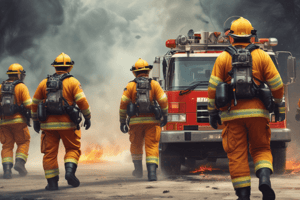Podcast
Questions and Answers
What is nozzle reaction force?
What is nozzle reaction force?
- A force that is not relevant to firefighting
- A force experienced by firefighters during training
- A force that increases with flow and nozzle pressure (correct)
- A force that reduces with flow and nozzle pressure
What are some nozzles designed to do?
What are some nozzles designed to do?
- Make it difficult to control the hose line
- Have no effect on nozzle reaction force
- Reduce nozzle reaction force (correct)
- Increase nozzle reaction force
What is the purpose of a standpipe system?
What is the purpose of a standpipe system?
- To provide water to a fire department pumper
- To increase the risk of flashover
- To reduce the pressure of the water supply
- To provide a location for hose connections (correct)
What is the standard attack hose line?
What is the standard attack hose line?
When is there a need for 2½-in. hose lines?
When is there a need for 2½-in. hose lines?
What is the most effective nozzle type for firefighting?
What is the most effective nozzle type for firefighting?
What type of sprinklers have better extinguishing qualities?
What type of sprinklers have better extinguishing qualities?
What is the "soften the target" tactic?
What is the "soften the target" tactic?
When should the "soften the target" tactic be used?
When should the "soften the target" tactic be used?
What is the critical point of the "soften the target" tactic?
What is the critical point of the "soften the target" tactic?
What is the preferred attack method in most situations?
What is the preferred attack method in most situations?
What is the UL research on the "soften the target" tactic?
What is the UL research on the "soften the target" tactic?
Flashcards are hidden until you start studying
Study Notes
- Firefighters must experience nozzle reaction force during training to handle it safely.
- Nozzle reaction force increases with flow and nozzle pressure.
- Some nozzles are designed to reduce nozzle reaction force or have devices to assist in controlling the hose line.
- Standpipe pressure can be significantly lower than those provided by a fire department pumper.
- NFPA 14 requires a sign to be posted stating the location, flow, and pressure of the two most hydraulically remote hose connections.
- Standpipe systems must be inspected and tested regularly.
- Aerial apparatus can be used as portable standpipes.
- Using a rope to advance a fire line to an upper floor is a time-consuming and complex tactic.
- The standard attack hose line is the first action in an offensive attack.
- When more than two 1¾-in. hose lines are needed to control the main body of fire, there is an obvious need for 2½-in. hose lines.
- Selecting the right nozzle type is important for effective firefighting
- Solid-stream nozzles may be more effective than fog streams
- Large-orifice/large-drop sprinklers have better extinguishing qualities
- Automatic variable-stream nozzles can provide both solid and variable streams
- Indirect attacks are limited in application and can be dangerous to occupants and firefighters
- Direct attacks are preferred in most situations where conditions permit
- Softening the target tactic involves applying water to the fire prior to making entry
- Proper ventilation is critical to prevent flashover and make interior conditions tenable
- Softening the target tactic may not be applicable in some situations
- Firefighter safety is a priority and should be considered in all tactics and strategies.
- The UL research on the "soften the target" tactic has been misinterpreted as an SOP to apply water to a fire as soon as possible from the safest location.
- The critical point is to apply water only if there is visible fire.
- The soften the target tactic is effective for fires rapidly growing toward flashover or in temporary decay waiting for fresh air.
- This method cannot be advocated or denounced as it may be ineffective under certain circumstances.
- The tactic may be extended to larger compartments, but results may vary.
- Larger compartments have more air space and available oxygen.
- Fire growth necessary to involve a large compartment could take longer than in residential occupancies.
- Small fires in large open areas may remain confined to a limited area.
- The method has merit but should be used with caution.
- The UL research applies only to fires with visible flames or heavy and/or pushing smoke conditions.
Studying That Suits You
Use AI to generate personalized quizzes and flashcards to suit your learning preferences.



